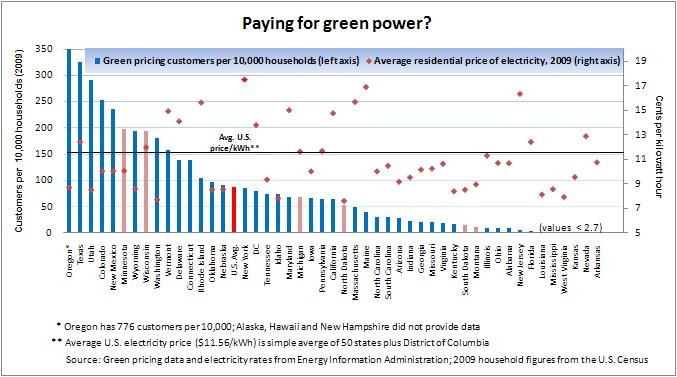Much has been made of efforts to increase the country’s renewable energy. A lot of the effort has been on the production side, requiring utility companies to garner a certain percentage of electricity output from renewable sources, like wind and solar power. (See previous fedgazette articles on renewable energy here and here.)
Despite the widespread public support for more renewable energy, so far it appears that many are not willing to put their money where their green side resides. Over the past decade or so, utility companies have rolled out literally hundreds of programs that allow consumers to consciously choose renewable power, but at a small premium over the normal cost of electricity (more on this in a bit).
Consumers who choose green-pricing programs are not necessarily receiving power from a renewable source when they turn on a computer or flat-screen television—the electricity grid is not capable of such pinpoint delivery. In essence, these programs ask consumers to pay more to support the development of renewable energy, which is more expensive than electricity generated by traditional sources like coal or nuclear.
This summer, the Energy Information Administration (EIA) released data that offer the most complete look at subscriptions to green-pricing programs across the country, and about the only safe conclusions are that such programs appear to be buzzing in some states, while snoozing in others. Oregon is by far the leader in green power subscriptions, with 776 subscribers per 10,000 households, almost triple the next closest state, Texas. At the other end, six states have fewer than three in 10,000 households participating (see chart; Ninth District states are highlighted in rose).

It’s hard to pinpoint the exact source of the disparity. Economic theory would suggest that program participation depends to some extent on prices—for both existing retail power and the premium charged to be a renewable power subscriber. Cheap electricity rates, for example, might allow and convince some to pay the premiums necessary to support renewable energy.
Unfortunately, that theory doesn’t appear to offer much of an explanation for the wide divergence among states. Seven of the top 10 states in green-power subscriptions—including Minnesota—have electricity rates that are below the national average. (Wisconsin is also in the top 10, but has above-average electricity rates.) Many other states have similarly cheap power at their fingertips, yet have very low participation in green-pricing programs (see chart).
The premiums charged for green power also offer clues. Oregon, the national leader, has 18 separate utility-run programs, many of which charge a premium of 1 to 2 cents per kilowatt hour (kWh) and have been in place since at least 2003. Even with the premium, participating Oregonians still pay less than the national average for electricity. At the other end of the spectrum, Arkansas has the lowest takeup rate in the country, with just 25 subscribers statewide in 2009. One reason is likely that the cost of the program is 5 cents/kWh—roughly a 50 percent increase in the state’s average power rate of about 11 cents/kWh). The program was also implemented in 2008, a comparatively short span to judge its attractiveness.
But there are also enough exceptions to the relationship between premiums and subscribers to suggest that other factors are at play. Montana barely moves the green-pricing needle despite electricity rates that are significantly lower than the national average, along with five green programs charging just 1.1 cents/kWh or less, and a sixth charging 2 cents/kWh. Ohio’s electricity rates are almost identical to Arkansas’ and it has eight green pricing programs that are significantly cheaper (0.5 to 2.5 cents/kWh), yet its participation rate is only slightly better than that of Arkansas (see chart).
Lastly, some states might have low subscription rates because programs are not widely available or are only newly available (as in Arkansas). Though the EIA’s review included the number of participating utilities in each state—which ranged from one in the District of Columbia to 100 in Minnesota—there was no information regarding green-pricing availability among all households in a state.
Ron Wirtz is a Minneapolis Fed regional outreach director. Ron tracks current business conditions, with a focus on employment and wages, construction, real estate, consumer spending, and tourism. In this role, he networks with businesses in the Bank’s six-state region and gives frequent speeches on economic conditions. Follow him on Twitter @RonWirtz.





